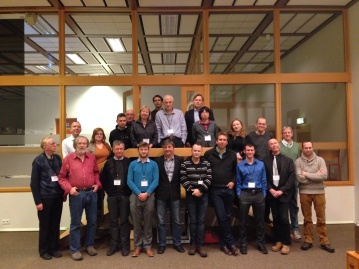Arctic Science Summit Week is the annual gathering of international scientists and policymakers who advance Arctic research. Through separate but related meetings and events, the Summit provides opportunities for international coordination, collaboration and cooperation in all fields of Arctic science.
The ASSW 2016 was held in Fairbanks (Alaska, US) on March 12-18, 2016 and included the 3rd Biennial Arctic Observing Summit (AOS 2016)
Our contribution to the ASSW and AOS 2016:
Przemysław Wyszyński¹, Daniel Klaus², Klaus Dethloff², Rajmund Przybylak¹, Annette Rinke² and Dörthe Handorf²
¹ – Nicolaus Copernicus University, Toruń, Poland
² – Alfred Wegener Institute, Potsdam, Germany
Abstract:
The HIRHAM5 regional climate model, developed at the Alfred Wegener Institute (AWI), with its pan-Arctic domain (including most areas north of 60N) was initialized and run over the time period from January 1, 1915 to December 31, 1940 with 6-hourly “NOAA-CIRES Twentieth Century Global Reanalysis Version 2” (20CRv2) forcing at the lateral boundaries. Sea-ice concentration and sea-surface temperature were prescribed based on daily 20CRv2 fields. Historical surface-based observations for the Arctic were collected and transcribed by Nicolaus Copernicus University (NCU) within various data-retrieval projects (e.g. AWAKE, AWAKE-2, ArcRu). With the aid of the 6-hourly HIRHAM5 model output, 20CRv2 reanalysis data, and surface-based observations carried out at Franz Josef Land stations, e.g. Tikhaya Bay (52.8E, 80.32N), the reproducibility of the early Arctic warming has been checked. Both the model and reanalysis have been evaluated by comparison with the measured sea level pressure, 2m air temperature, 2m specific humidity, and 10m wind speed. More importantly, the vertical baroclinic structure of the atmosphere has been analyzed by use of radiosonde data that have been acquired in the framework of ERA-CLIM. Finally, the upgraded Twentieth Century Global Reanalysis dataset (20CRv2c), has been also taken into account. The latter was improved not only by assimilating additional surface pressure data (e.g. from Teplitz Bay 1899-1900, provided by NCU) but also by using the Centennial Observation-Based Estimates of SST version 2 (COBE-SST2) instead of the Hadley Centre Sea Ice and Sea Surface Temperature data set (HadISST1.1) to prescribe sea-surface temperature and sea-ice concentration. It can be expected that HIRHAM5 performs equally well as the 20CRv2 data, but it is unclear whether the model is even able to reproduce the station observations with the same quality as the improved 20CRv2c (corrected 20CRv2) reanalysis data. If the model has the skill to perform comparably or even better than 20CRv2c this might give evidence of a more realistic simulation of Arctic clouds, which will be checked as well. Acknowledgements: The research work was supported by a grant funded by the National Science Centre by decision No. DEC-2012/07/B/ST10/04002.
Moreover Przemek attended the meeting of the Atmospheric Working Group of the International Arctic Science Committee (IASC)



